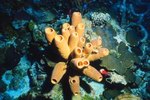
Roughly 5,000 crab species exist worldwide. Only 4,500 of these are true crabs, however, the other 500 being hermit crabs. While the majority of species are fully aquatic, some are semi-aquatic and others live exclusively on land. Although differences exist between species, they also have many similar characteristics, some of which are specialist adaptations to help their survival.
Awesome Armor
Unlike most creatures we commonly see, crabs don't have an internal skeleton. Instead, their skeletons are on the outside and are known as exoskeletons. The main part of their bodies, or their shells, are called carapaces. They provide a similar kind of structural rigidity that our skeletons provide us. They're also extremely hard and protect the crabs' internal organs, as well as making them less susceptible to attacks from predators.
Essential Claws
All crabs have eight regular legs and two specially adapted legs known as chelipeds or claws. These chelipeds have several important uses. They help them to feed and to catch prey. They're also useful when it comes to fighting and defending themselves from predators. Finally, male crabs of some species make use of their chelipeds during mating season, either to put on displays for females or to fight off other males to win some feminine attention.
The Trick Is to Keep Breathing
Those crabs that spend all or most of their time in the water breathe using gills. The problem comes when these crabs are on dry land, as they still need water to breathe. Some species have special plates they can close up tightly to keep water inside their bodies, which they can use to breathe; other drink water from pools or puddles or store water in their bladders or blood. True land crabs don't have gills, but rather have adapted large cavities inside their bodies that act in a similar way to lungs, allowing them to breathe air.
Good Senses
All crabs have both a set of antennae and antennules. The former allow them to feel the world around them, whereas the latter use chemoreception to let crabs smell and taste their environment They see through their eyes, which are located on the end of long eyestalks. The purpose of these eyestalks is to allow them a better field of vision -- they can see in front of themselves, behind themselves and to the sides -- which is an advantage when hunting or looking out for danger.
References
Photo Credits
-
NA/AbleStock.com/Getty Images




